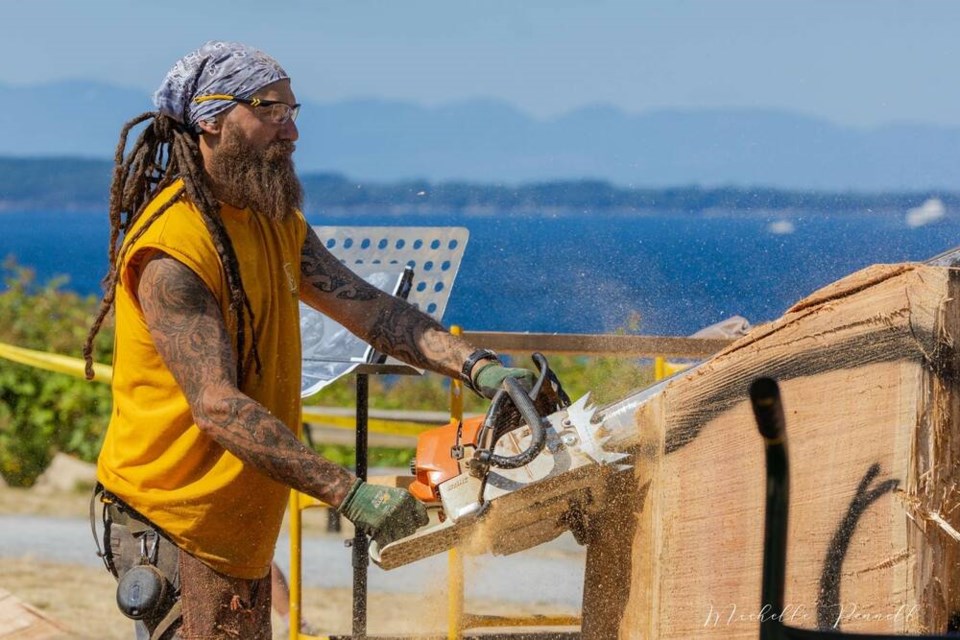Paintbrushes, pencils, palette knives … there are certain implements expected to be found within an artist’s arsenal. A power tool, however, doesn’t usually make the list. Yet Ben Hemara, wood carver and chainsaw master, isn’t your average artist.
With old tree trunks as his medium, Hemara creates intricate carvings that pay homage to the natural world, referencing the abundant wildlife found in British Columbia and his native New Zealand.
“It’s beautiful here,” said Hemara, who moved to North Vancouver in 2011. “My favourite subject is wildlife and, living in B.C., I just love the wildlife here. Growing up in New Zealand it was a dream of mine as a young boy to see a bald eagle. I’ll never forget the day I saw one, my mouth just dropped to the ground because they’re just so majestic, so they regularly make an appearance in my work.”
Bears are a common motif too, alongside Hemara’s favourite birds from home: Kiwis, of course, and the high-spirited tūī.
Growing up in Hastings, in the Hawke’s Bay region of New Zealand, and being of Māori descent, Hemara said he has always been exposed to wood carving as an art form, but it wasn’t until he moved to Canada that he pursued it himself.
“I was always fascinated with carving, but I never had the opportunity to do it at that level back home. When I moved here, there was a small class at Lee Valley Tools on how to carve faces by hand, and I did really good at it.”
The one-day session gave Hemara a taste for carving, yet he still yearned for something that would help him create on a larger scale, and faster. Enter: the chainsaw.
Weeks of poring over chainsaw carving videos on YouTube prepared him for having a shot at the real thing when he bumped into carving icon Pete Ryan one summer’s afternoon while driving through Hope.
“I was lucky enough to be able to meet Pete and he mentored me for a few weeks,” said Hemara. “He was incredible.”
Ryan died one year later in 2021, aged 70, but not before passing his knowledge on to his carving protegee. Now Hemara, “channelling him the whole time,” said his own style echoes his icon’s and he plans to carry on Ryan’s legacy, gifting the local community with uplifting art.
Hemara’s artistic contributions can be found on local trails as public art pieces and in the homes of both locals and New Zealanders as personalized commissions. Prize-worthy pieces can also be found throughout the province, as he continues to make waves on the carving competition and events circuit.
Just last month, Hemara crafted a pair of leaping wolves from an eight-foot-tall cedar log at the four-day Transformation on the Shore event in Campbell River. He didn’t place at the event as it hadn’t been an official competition, but he was told his large-scale sculpture, named Pursuit, was a firm favourite.
At the more recent Powell River Logging Sports event, a three-day competition that sees 12 carvers compete, Hemara’s carved lion only just missed out on the top spot, with the panel finding it so difficult to crown the winner “they had to bring in a fourth judge.”
Yet while Hemara hasn't nabbed an official trophy, events like these are still winning experiences, he said, because the social connection and education opportunities are unlike any that can be found off the field.
“When the carvers get together in the summer for these big competitions, it’s a brotherhood, and we all welcome each other. We all hug each other and help each other because we’re working so hard, and we all learn from each other too,” he said.
“There could be a caver that has a certain technique or a tool that none of us have seen before, and we all share that information so we can all succeed together. There is success for everyone in this art form.”
Carving, said Hemara, is an art form that can be pursued by everyone, provided they are aware it takes a lot of practice and patience. For the bestial creations like his own, for example, it requires “a lot of homework studying anatomy, studying bone structures” to create a piece he is proud of.
“It takes a bit of time, but anyone can do it. Don’t be afraid to try something new. It’s never too late. I encourage anyone to give it a try,” said Hemara, adding that beginners should have supervision, "obviously.”
Mina Kerr-Lazenby is the North Shore News’ Indigenous and civic affairs reporter. This reporting beat is made possible by the Local Journalism Initiative.



